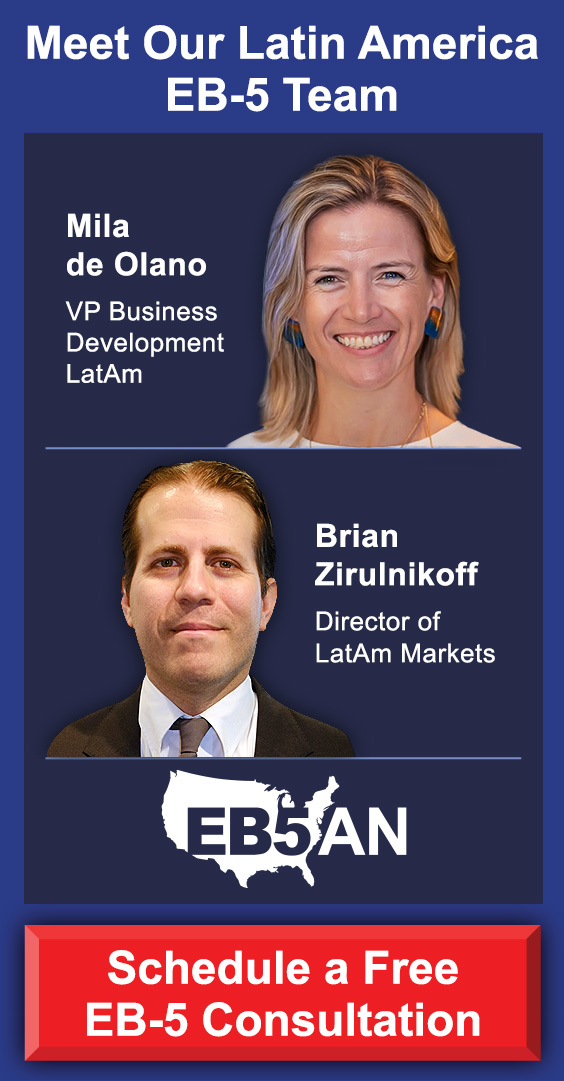Among many Indian nationals, there has been growing interest in recent years in immigrating to the United States of America for better economic and educational opportunities. Fortunately, the United States offers several pathways for foreign nationals to obtain permanent residency, and one of the most attractive options is through a U.S. visa in the immigrant investor category.
These types of visas are extremely popular because they allow individuals to secure permanent resident status (also known as a Green Card) by making a qualifying capital investment, thereby promoting economic growth in the United States. Investment visas offer a flexible immigration option without requiring employer sponsorship. The most well-known type of investment visa is the EB-5 Immigrant Investor Program, which provides a direct route to U.S. permanent residency for investors and their immediate families. EB-5 visa holders can live, work, and study anywhere in the United States, making it an especially appealing choice for families seeking better educational and professional opportunities.
This article will provide an overview of U.S. investment visas, explore the many advantages of the EB-5 visa, and provide a detailed explanation of the EB-5 program’s process, requirements, costs, and other considerations that Indian immigrant investors should take into account.
What Is an Investment Visa?
What Are the Advantages of the EB-5 Immigrant Investor Program for Indian Nationals?
Understanding U.S. Citizenship and Immigration Services (USCIS) EB-5 Program Requirements
- Making the Required Investment in a New Commercial Enterprise (NCE)
- Meeting the Job Creation Requirements
- Investing Directly or Through a Regional Center?
What Is the Process for Getting an EB-5 Visa?
How Much Does an EB-5 Visa Cost for Indian Nationals?
Other Considerations to Be Aware of as an Indian EB-5 Investor
- Understanding the Reserve Bank of India’s Liberalized Remittance Scheme (LRS)
- Visa Backlogs and Processing Times
- Documenting Lawful Source of Funds
- Conducting Due Diligence
Obtain a Green Card and Get on the Path to U.S. Citizenship With EB5AN
What Is an Investment Visa?
A U.S. investment visa allows Indian immigrant investors to become lawful permanent residents in the United States by making a qualifying financial investment. The EB-5 Immigrant Investor Program—which has a stated goal of promoting economic growth through foreign investment—is the most well-known type of investment visa. It requires a minimum investment of $800,000 for projects located in a targeted employment area (TEA) or $1,050,000 in other areas. Foreign investors must also create at least 10 full-time jobs for U.S. workers to qualify.
These investment visas are popular because they offer a direct path to U.S. permanent residency for the investor, their spouse, and eligible family members (any unmarried children under the age of 21). Unlike other employment-based visas, EB-5 investors do not need employment sponsorship or a job offer to qualify. In addition, the EB-5 program provides extraordinary flexibility, allowing investors to live, work, and study anywhere in the United States of America.
The second type of U.S. investment visa is the E-2 Treaty Investor Visa. The E-2 visa is a nonimmigrant visa available to nationals of countries that have an investment treaty with the United States. India does not qualify directly, as it is not among the countries that maintains a treaty of commerce and navigation with the U.S. Unlike the EB-5 visa, which is an immigrant visa, the E-2 visa does not lead directly to a Green Card but can be renewed indefinitely as long as the business in which the investment was made remains operational. However, because India is not a treaty country, the EB-5 Immigrant Investor Program is the primary investment-based pathway to U.S. permanent residency for Indian immigrant investors.
What Are the Advantages of the EB-5 Immigrant Investor Program for Indian Nationals?
Investing in the EB-5 Immigrant Investor Program offers a number of clear benefits for Indian nationals seeking a U.S. permanent resident card—also known as a Green Card. Some of the key advantages of an EB-5 investment visa are:
- Immigration With Family Members: When an Indian national chooses the EB-5 program, their entire family can immigrate with them. An investor’s spouse and unmarried children under the age of 21 can obtain conditional permanent resident status (also known as a conditional Green Card) and then acquire a permanent Green Card, along with the primary applicant.
- Freedom to Live and Work Anywhere in the U.S.: Unlike certain visa categories that tie individuals to specific employers or locations, EB-5 investors and their families can choose to live and work anywhere in the United States.
- Access to the U.S. Education System: The EB-5 visa lets Indian nationals gain access to the United States education system, from primary and secondary schools to colleges and universities. Moreover, EB-5 residents may qualify for scholarships, grants, and, in some cases, in-state university tuition rates.
- Employment Flexibility: EB-5 visa holders are not restricted to specific job types or employers, allowing them to pursue various employment opportunities or start their own businesses.
- Travel Benefits: Although there are restrictions on how long a conditional Green Card holder can spend abroad, investors are free to travel in and out of the United States with a valid passport.
- Quick Path to Acquire Permanent Resident Status and U.S. Citizenship: In many cases, an EB-5 visa can make the immigration process significantly faster than with other types of visas. The initial conditional permanent resident status can be removed after two years, and EB-5 investors are eligible to apply for U.S. citizenship after residing in the country for just five years in total.
- Opportunity for Passive Investment: By making an EB-5 investment through a regional center—an entity designated by USCIS to pool and manage investments from multiple EB-5 investors—foreign investors can take a more passive role than in cases of business ownership, as regional centers manage the day-to-day operations of the investment project.
- Potential for Full Repayment: While the primary goal for most EB-5 investors is obtaining permanent resident status with a Green Card and enjoying the benefits that accompany permanent residency, EB-5 investments may result in the full repayment of the investment capital (plus profits in some cases) if the project succeeds.
Understanding U.S. Citizenship and Immigration Services (USCIS) EB-5 Program Requirements
The goal of the EB-5 Immigrant Investor Program is to stimulate economic growth by attracting capital investment from foreign nationals in exchange for a U.S. Green Card. Economic growth is measured in terms of job creation for U.S. workers. There are several key requirements that an alien investor must keep in mind when deciding to pursue EB-5 visa status:
Making the Required Investment in a New Commercial Enterprise (NCE)
As previously mentioned, the minimum investment amount is $800,000 for a project located in a targeted employment area (TEA) and $1,050,000 for non-TEA projects. All EB-5 investors must invest the necessary capital into a qualifying new commercial enterprise (NCE). USCIS defines a new commercial enterprise as “any for-profit activity formed for the ongoing conduct of lawful business.”
Meeting the Job Creation Requirements
The intended goal of the foreign investment resulting from the EB-5 Immigrant Investor Program is to create jobs for U.S. workers. Each EB-5 investment must lead to the creation of at least 10 jobs that last for a minimum of two years. If the required jobs have not been created by the time an investor is eligible to file their I-829 petition, they will not yet be eligible to receive a permanent residence status and a U.S. Green Card.
Investing Directly or Through a Regional Center?
EB-5 applicants can choose between two types of investment options: a direct investment or an investment through a regional center. A direct investment involves contributing capital directly to a new commercial enterprise (NCE) and often requires active, long-term involvement in managing the NCE. This is typically the route chosen by investors who are interested in business ownership. On the other hand, regional centers are entities designed to pool funds from multiple investors and manage those funds on their behalf. The overwhelming majority of EB-5 investors focused on securing permanent residence and a U.S. Green Card quickly and with minimal risk choose the regional center option.
Investing through the regional center program also provides other benefits. Regional centers may submit exemplar petitions, which can help streamline the Green Card application process of individual investor petitions by pre-approving key project documents. EB-5 regional centers can also count indirect jobs and induced jobs (in addition to direct job creation) toward the job creation requirement.
Due to these major advantages, and the reduced financial risk that comes with investing through any of a wide range of reliable EB-5 regional centers, most Indian EB-5 investors opt to make their EB-5 investment through a regional center.
What Is the Process for Getting an EB-5 Visa?
The EB-5 investment process consists of several key steps. First, an Indian national submits the I-526E immigrant petition to U.S. Citizenship and Immigration Services (USCIS). This application verifies the investor’s compliance with program regulations and includes details about their investment, background, and the new commercial enterprise (NCE). Once USCIS approves the petition, the investor receives a conditional Green Card for two years.
In the final 90 days of this conditional permanent resident period, the investor must file the I-829 immigrant petition to confirm they have met all EB-5 investment program requirements. Upon approval, both the investor and their immediate family members can convert their conditional Green Card to a permanent U.S. Green Card.
Given the complexity of the EB-5 process and the extensive documentation required, seeking guidance from immigration law experts and EB-5 professionals is highly recommended. Expert advice helps streamline the process, ensuring compliance and minimizing potential challenges.
Learn more about the step-by-step process of applying for the EB-5 program here.
How Much Does an EB-5 Visa Cost for Indian Nationals?
In addition to the minimum investment capital required—which is $800,000 for projects located in a targeted employment area—there are some other costs associated with applying for an EB-5 visa.
There is a filing fee associated with immigration petitions, as well as a filing fee for I-485 forms and I-829 forms that are typically in the range of several thousand dollars. For applicants not physically present in the United States, there is also a consular processing fee of about $450 per applicant.
Most importantly, EB-5 applicants should also plan appropriate fees for legal and professional services, as conducting thorough due diligence and working with experienced immigration attorneys is highly recommended.
Other Considerations to Be Aware of as an Indian EB-5 Investor
The EB-5 program offers Indian nationals a low-risk pathway to lawful permanent residence status. However, several critical considerations must be addressed to navigate this process effectively and efficiently.
Understanding the Reserve Bank of India’s Liberalized Remittance Scheme (LRS)
The Reserve Bank of India’s Liberalized Remittance Scheme (LRS) allows Indian residents to remit up to $250,000 per financial year for specific purposes, including overseas investments. Given the EB-5 program’s minimum investment amount of $800,000, investors often need to strategize their remittances. It’s imperative to ensure compliance with LRS guidelines to avoid penalties.
Visa Backlogs and Processing Times
Indian EB-5 visa applicants may face extended processing times in the unreserved visa categories due to high demand. Investing in a rural area that qualifies as a targeted employment area (TEA) can result in significantly faster processing times because USCIS reserves about a third of annual visas as “set-aside visas” specifically for projects in targeted employment areas and offers priority processing to rural project investors as long as they have visas available to them. Learn more about EB-5 visa processing times for Indian nationals here.
Documenting Lawful Source of Funds
All EB-5 investors must provide comprehensive documentation proving that their investment funds originate from lawful sources. This process involves presenting clear financial records, tax returns, and other relevant documents to demonstrate the legitimacy of the funds. Thorough and transparent documentation is crucial to meet U.S. Citizenship and Immigration Services (USCIS) requirements and avoid application delays or denials.
Conducting Due Diligence
Investing in an EB-5 project requires thorough due diligence. Evaluating the project’s viability, financial stability, and compliance with EB-5 requirements is essential. Working with experienced immigration attorneys and EB-5 program experts can help navigate complexities, ensure informed decisions, and reduce the risk of processing delays, resulting in a smoother path to U.S. permanent residency for Indian nationals and their families.
Obtain a Green Card and Get on the Path to U.S. Citizenship With EB5AN
For Indian nationals with the means to invest, the EB-5 Immigrant Investor Program is one of the most efficient and least risky ways to obtain permanent residence status and a U.S. Green Card, and also to get on a clear path to U.S. citizenship. With the support and guidance of EB-5 program experts and licensed immigration attorneys, Indian nationals pursuing an EB-5 visa can set a target of obtaining permanent residency status more quickly than with any other visa categories.
EB5AN’s expert team has more than a decade of experience, and offers clients first-rate, low-risk targeted investment area (TEA) projects with a 100% USCIS project approval rate to date. EB5AN has helped more than 2,300 families from 70+ countries navigate the U.S. Green Card process.
To begin your family’s journey toward becoming U.S. Green Card holders, schedule a free meeting with EB5AN today.










